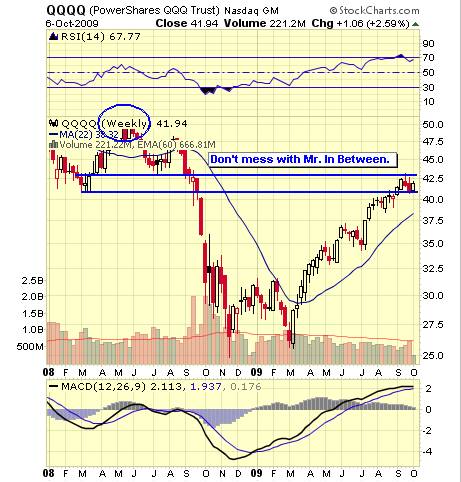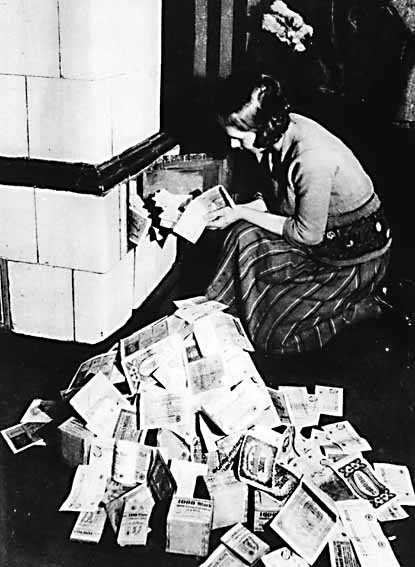 When your first trade of the day is a cover, you know you are too bearish!
When your first trade of the day is a cover, you know you are too bearish!
That’s what happened to us yesterday when I sent out a 9:47 Trade Alert to Members for the QQQQ $41/42 bull call spread at .57 to cover the too bearish stance I was worried about in the morning post. We exited that trade at .70 (up 22%) and that served it’s purpose of giving us some cash to put into rolling up our puts, following through on the strategy laid out in the morning post. As I said at the time, these are the moves we’re making BEFORE we capitulate and our short plays will form a base from which we can aggressively go long once we clear our targets.
I called off that QQQQ trade at 11:32, about 9 cents off the high of the day as they looked about to fail our 42 target which, as you can see from David Fry’s chart, is right about the middle of the weekly range so it’s a level we have to respect on multiple fronts. We’re still waiting for a proper test of that 40 line, a 5% drop from here and PSQ (short QQQQ) calls are the main protection in our $100K Virtual Portfolio at the moment. Any move below 40 on the Qs can re-shape the chart to a much more bearish formation long-term.
 We also covered up our long DIA puts, which flipped us more bullish overall and ended the day half-covered – neutral and confused but with more aggressive puts than we had on Monday so some small progress was made. In addition to rolling up our bear plays like GLD puts, we added hedged January bullish plays on EDZ and TZA, went bullish on RIMM as they sold off to $65, bearish on MOS as they ran up to $49, bullish on WFR at $16, bearish on FCX at $70, April bullish and hedged on SKF, bearish on OIH at $118.50, Jan bearish and hedged on TIF at $40.75, bullish and hedged on April SCO and bullish on FXP at $9.45. Overall a pretty busy and bearish day of trading.
We also covered up our long DIA puts, which flipped us more bullish overall and ended the day half-covered – neutral and confused but with more aggressive puts than we had on Monday so some small progress was made. In addition to rolling up our bear plays like GLD puts, we added hedged January bullish plays on EDZ and TZA, went bullish on RIMM as they sold off to $65, bearish on MOS as they ran up to $49, bullish on WFR at $16, bearish on FCX at $70, April bullish and hedged on SKF, bearish on OIH at $118.50, Jan bearish and hedged on TIF at $40.75, bullish and hedged on April SCO and bullish on FXP at $9.45. Overall a pretty busy and bearish day of trading.
As I said to members in my closing comments, the XLF couldn’t hold $15 and the Qs couldn’t hold 42, which were both watch levels for us during the day. The index levels we were targeting were a mixed bag as we were looking for upside resistance at Dow 9,700, S&P 1,060, Nas 2,120, NYSE 6,950 and Russell 610 and we got Dow 9,731, S&P 1,055, Nas 2,103, NYSE 6,899 and Russell 601. The most concerning is the NYSE, which is the only major US index still trading more than 33% off it’s highs. Our goal line there is 6,959 so that’s going to be our mark for a bullish flip going forward. We can always go back and add another bull call spread if the markets head higher to day but, if the dollar is putting in a floor here.
What is keeping us most bearish is that I think the dollar is way oversold and this "rally" has been nothing more than a commodity run spurred on by severe dollar weakness that, as I pointed out yesterday, is being driven by rumors – not fundamentals. David Merkel has an excellent article on the dollar this morning in which he points out:
It is not that easy to abandon the US Dollar. Where do you go? The yen will suffer for years as Japan heads into demographic decline and large structural budget deficits. The Euro is still an experiment; there are many pressures on it; its survival is not assured. Nothing else is large enough, stable enough, or mature enough to run the deficits necessary to have the debt markets, to be the global reserve currency. As an example, China does not want to run deficits, nor is its financial system strong enough to bear the wear and tear of global use of its currency.
Why is oil up 75% from last November? Consumption is down, there were no hurricanes, spare capacity is up, inventories are up at record levels and even the forecast of 1.7% growth for 2010 may be based on overly-optimistic expectations for our economy. If oil were a company, would you be paying 75% over the price it held 11 months ago, when consumption was 3.7% higher? How about if it was based on a forecast that consumption would rise 1.7% next year – from 90% to 91.53% of our consumption in 2007, when oil averaged $70 for the year? We’re not even going to get into the fact that oil bottomed out at $35.13 in December, when our consumption was still running 4% better than it is now.

The only thing that changed oil’s fortunes in 2009 is the fact that the dollar has fallen from 88 last winter all the way down to 76 today. That’s a 13.6% decline in the dollar and is the ONLY justification for a 75% increase in oil. That’s why you are seeing the dollar coming under constant attack lately as oil speculators are sitting on 294M barrels worth of contracts for November delivery and another 213M barrels worth of contracts for December delivery and 87M barrels worth of contracts for January delivery. As my readers may remember, 450M contracts is "normal" for the three front months so almost 600M barrels is what they call in the NYMEX pits – BIG TROUBLE.
 So we have overextended oil, gold, silver and copper prices yet the DBC is still at 22.13. That’s interesting. Perhaps we’ve found a bull cover we can take or perhaps it underscores how ridiculous these runs in individual commodities have become. DBC is still 50% off it’s highs and not looking particularly like it’s breaking out any time soon. There are a couple of ways to use DBC as a hedge:
So we have overextended oil, gold, silver and copper prices yet the DBC is still at 22.13. That’s interesting. Perhaps we’ve found a bull cover we can take or perhaps it underscores how ridiculous these runs in individual commodities have become. DBC is still 50% off it’s highs and not looking particularly like it’s breaking out any time soon. There are a couple of ways to use DBC as a hedge:
The 2011 $20 calls are very reasonable at $3.90, with just $1.77 in premium over 15 months (.12 per month) and you can half cover with Nov $23 calls at .40 to knock out the premium and give you a 2.5% return on your investment in the first 45 days.
We also like our bull call spreads in these situations and the April $19 calls are $3.55 and you can sell the Apr $22 calls for $1.70, which puts you in the $3 spread for net $1.85, which pays you back 176% if DBC holds $22 through April.
Those are nice ways to hedge against a continued run in the commodity sector if you have been taking some of our shorter-term commodity shorts. Our time-frames are mainly Jan and April so we can offset 4 bearish plays that lose 20% with the one bullish spread on DBC that will pay us 76% if DBC simply doesn’t go any lower. I dont’ think we’ll need them because the fundamentals don’t support these prices in the least, but it’s good to have a plan to cover – just in case I’m wrong…
Another part of the economy I’m concerned about it the REIT sector but members got an earful of my concerns there last night so I won’t rehash it all here but I do urge them all to read that post as there’s some very scary data to mull over. As I said to members early this morning: The Hang Seng are just below their 33% mark (21,440) this morning so that will be interesting but the Nikkei is miles away at 9,799, needing 12,261 to get within 1/3 of their crazy highs. The FTSE is within striking distance of 20% off and the DAX is just over 33% but the CAC is nowhere close, currently 8.5% below 33% off at 4,200 so Europe is, in short, all over the place and not a great indicator.
 We’ll see what happens at 10:30, when we get the oil inventory report but there’s no major news today other than the Fed Budget at 2pm but I think we have lost our capacity to be shocked by how deeply in debt our government is. Not the European Commission though, they, in fact have officially warned Austria, Belgium, the Czech Republic, GERMANY, ITALY, Slovakia, Slovenia, the Netherlands and Portugal that their budget deficits are too large and must come down to the agreed upon 3% of GDP levels. The commission has determined that these deficits are neither close to the reference value nor temporary and they will now be subject to the "Excessive Deficit Procedure." This is going to be interesting!
We’ll see what happens at 10:30, when we get the oil inventory report but there’s no major news today other than the Fed Budget at 2pm but I think we have lost our capacity to be shocked by how deeply in debt our government is. Not the European Commission though, they, in fact have officially warned Austria, Belgium, the Czech Republic, GERMANY, ITALY, Slovakia, Slovenia, the Netherlands and Portugal that their budget deficits are too large and must come down to the agreed upon 3% of GDP levels. The commission has determined that these deficits are neither close to the reference value nor temporary and they will now be subject to the "Excessive Deficit Procedure." This is going to be interesting!
Meanwhile, back in the good old USA (ie. Deficits R Us), EVERYBODY beat earnings today: ANGO, YUM, AYI, COST, FDO, HELE, MON and WWW all turnned in beats but MON lowered guidance and ruined an otherwise nice party.
So strong earnings and guidance might change my mind about the economy. We did see a rise in Mortgage Applications but that was primarily driven by refinancing. Purchases were off 2.2% from last year so still not very good. Of course mortgage demand is based on rates and rates are not likely to stay low if the Dollar stays weak and a weak Dollar also drags money out of consumers pockets, diverting discretionary income in to commodity purchases which do no good at all for the US economy other than the commodity pushers themselves. Only 19% of respondents in Discover’s U.S. Spending Monitor said they expect to spend more in the next month, even though 33% now feel an improvement in economic conditions. "There appears to be no indication consumers are willing to increase their spending," Discover’s Julie Loeger says.
So yep, I’m still cautious!


